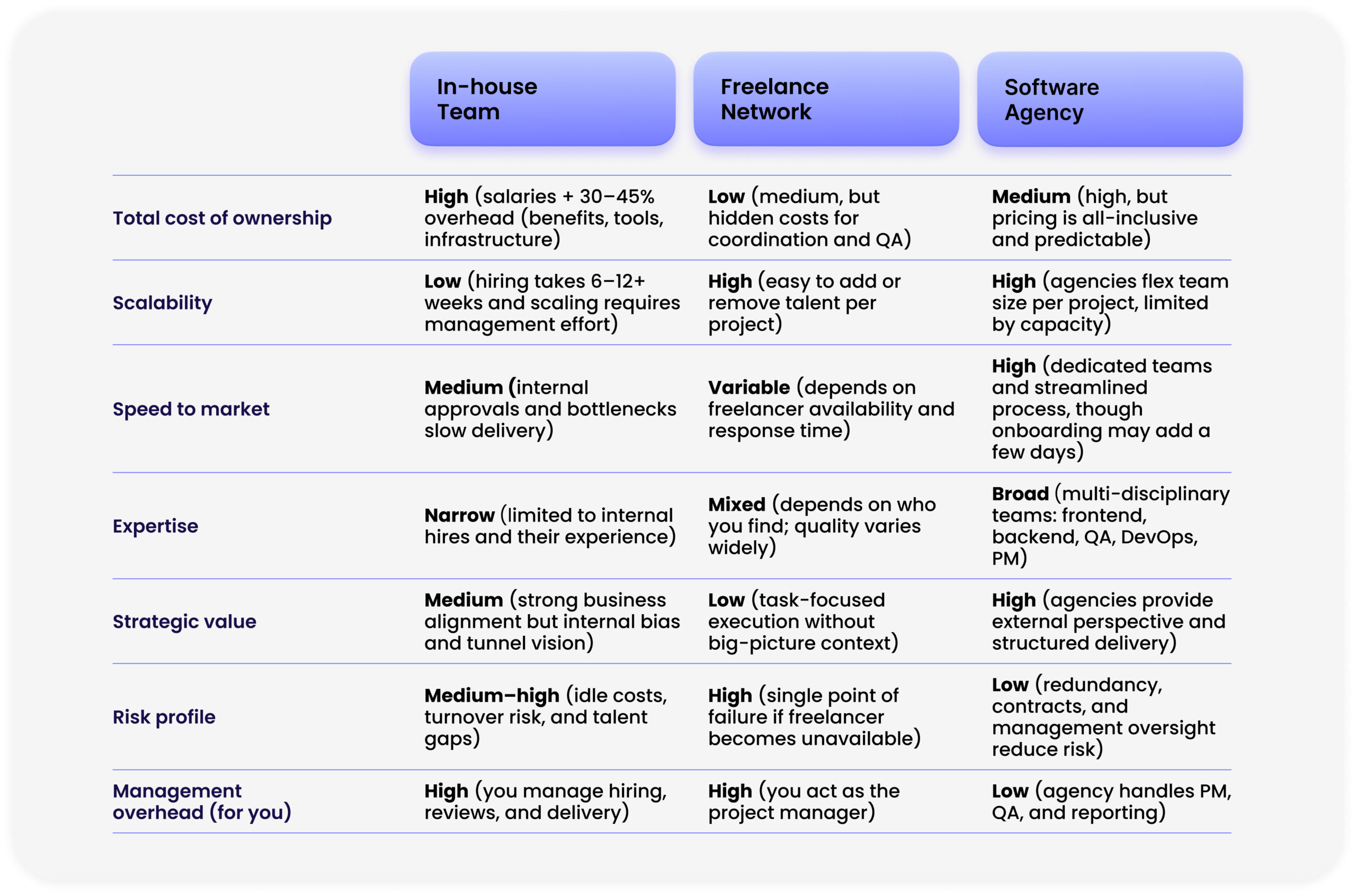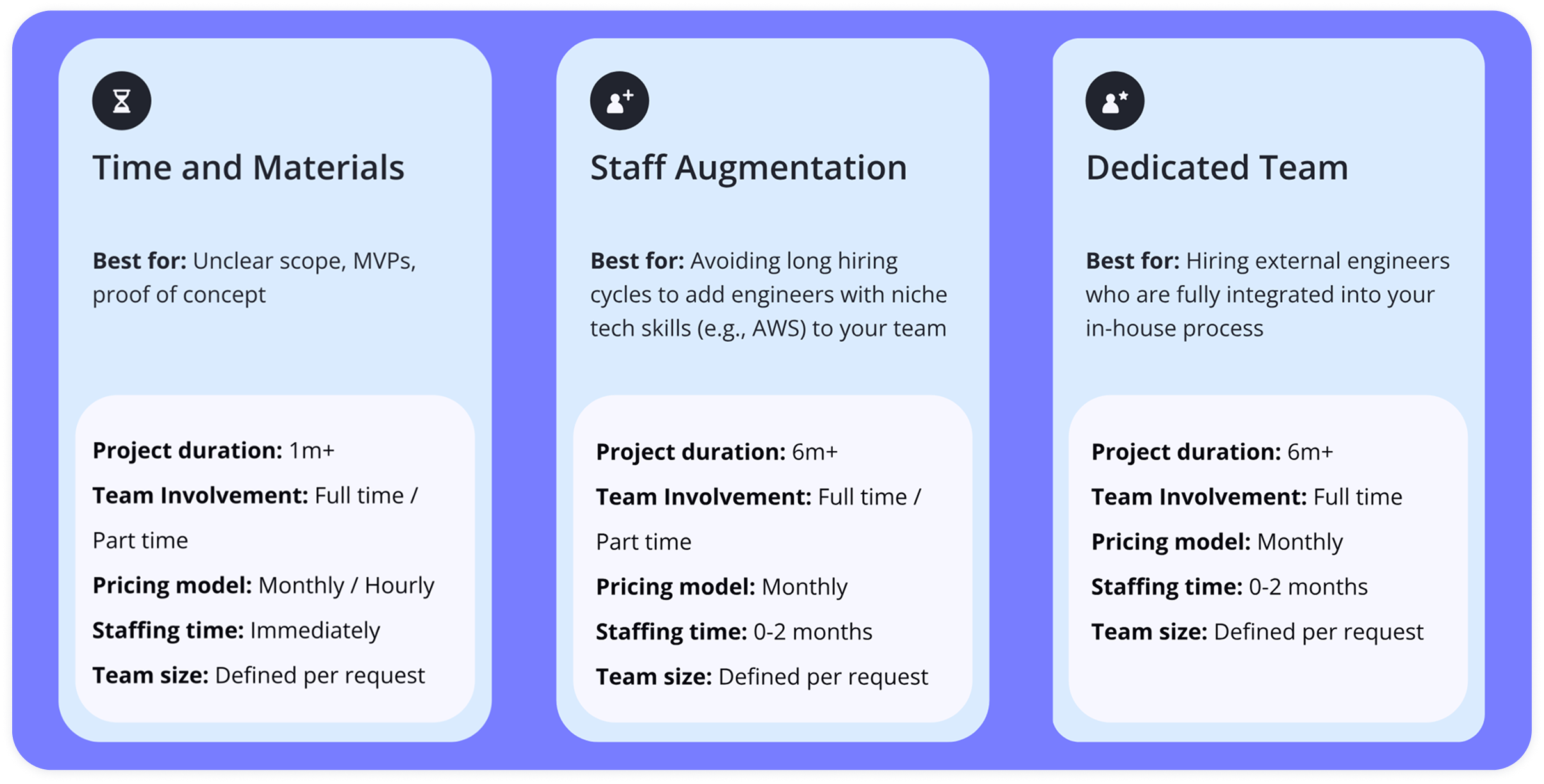Most companies need software built. The question becomes: freelancer, agency, or hire developers full-time? Each choice carries different costs, timelines, and headaches.
Most founders pick based on the number that looks smallest upfront. A freelancer’s hourly rate seems cheaper than an agency’s project quote. An in-house developer’s salary appears more predictable than either.
But those initial numbers don’t tell you much. Add up the real expenses over six months – project delays, management time, quality issues, knowledge transfer problems – and suddenly the “expensive” option starts looking smart.
Let’s break down what each approach actually costs when you factor in everything that matters for your business.

Freelancers: Speed vs. Stability
Need a developer tomorrow? Freelancers can start your project within days. This speed and flexibility make freelancers the go-to choice for 73% of small businesses tackling short-term development needs, but that convenience comes with trade-offs worth understanding before you commit.
Key Advantages
Flexibility and speed. Freelancers let you hire specialized developers for specific technologies and launch projects within days, no lengthy contracts or negotiations. Need a UI expert or backend specialist? You can engage precisely the expertise your project requires.
Cost efficiency. Freelancers typically cost 30-50% less than agencies. You pay for work delivered, not overhead like benefits, office space, or management infrastructure. For budget-conscious businesses, this makes freelancers highly attractive.
Pay-as-you-go model. Scale up or down based on project demands without long-term commitments. Pause work between sprints, bring freelancers back for updates, or end the engagement when the project completes.
Significant Risks
Availability uncertainty. Your freelancer might become unavailable due to illness, emergencies, or higher-paying opportunities. With no institutional backup, you’re dependent on a single person with no obligation to prioritize your work.
Capacity constraints. Most skilled freelancers juggle multiple projects. Your urgent requests compete with other clients’ priorities. When freelancers move on, they take critical knowledge of your codebase and processes with them.
Hidden cost escalation. While freelancers appear budget-friendly upfront, project delays from availability gaps, knowledge transfer issues, and quality inconsistencies can quickly erode initial savings. Inconsistent delivery may cost more than reliable agency teams that ship on time.
Communication demands. Remote freelancer relationships require rigorous protocols for updates, deliverable reviews, and issue resolution, or projects stall.
When Freelancers Work Best
Freelancers work best for well-defined projects with limited scope, one-off tasks, or specialized services where you need specific technical knowledge quickly without long-term commitment. They excel in agile projects where you have strong internal technical leadership to guide the software development process and can accept the risk of individual dependency.
In-House Teams: Maximum Control, Maximum Investment
In-house development represents the biggest commitment but offers the most control. You’re not just hiring developers, you’re building internal capability that becomes part of your competitive advantage. This approach makes sense when software is central to your business, not just a support function.
Strategic Advantages of In-house Teams
Complete control and alignment. Building an internal software development team gives you full control over project focus and creates a deep understanding of your business goals that compounds over time. Your developers become intimate with your business model, user base, and technical architecture in ways external resources rarely achieve.
Instant communication and rapid iteration. In-house teams can participate in strategic planning sessions, make architectural decisions based on deep business understanding, and enable rapid experimentation that external teams struggle to match. No waiting for meetings or explaining context – they’re already part of your business strategy.
Long-term quality and consistency. Benefits accumulate over months and years within well-structured teams. In-house developers maintain coding standards, architectural patterns, and documentation practices that create long-term maintainability while understanding the technical debt implications of shortcuts.
Compound business knowledge. The investment in company-specific technical knowledge creates compound returns. Software engineers who understand your business context make better architectural decisions, identify optimization opportunities, and solve problems more efficiently than external resources working from specifications.
For companies not ready for full hiring commitments, IT staff augmentation offers a middle-ground approach, allowing you to add skilled developers to your existing team on a temporary or project basis while maintaining more control than traditional outsourcing.
Substantial Costs and Organizational Challenges
High total cost of ownership. The financial commitment extends far beyond salary costs when hiring full-time employees. Total compensation, including benefits, payroll taxes, equipment, and office space, often doubles apparent salary costs, creating substantial annual expenses per developer.
Long hiring and scaling delays. Finding quality software developers takes 3-6 months on average, plus additional time for team chemistry and full productivity. Teams beyond 5-7 people need management infrastructure and coordination processes that slow down development velocity.
Fixed costs and retention risks. Your development team costs the same whether they’re building critical features or waiting for requirements. Key developers leaving can cripple projects and take critical business knowledge with them, unlike agencies with backup resources.
Effective remote team communication strategies become essential as in-house teams expand, particularly for companies embracing distributed work models or hybrid team arrangements.
Strategic Fit for In-house Development
In-house teams work best for larger companies with substantial, ongoing development needs where software drives core business value rather than supporting ancillary functions. Companies with multiple teams working on continuous integration, iterative development, or those requiring specialized expertise in their domain typically justify the investment in dedicated software development teams.
Agency Model: a Strategic Partner for Growth
Agencies sit between freelancers and in-house teams, offering structured development with more resources than individual contractors but without the long-term commitment of hiring. They work best when you need a full team but don’t want to manage the pieces yourself.
Core Strengths of Agency Teams
Ready-made team diversity and cross-departmental expertise. Development agencies provide complete software development teams with established structures, offering comprehensive services without managing individual contractor relationships. A typical project team includes frontend developers, backend engineers, software architects, and dedicated project managers working in coordination. Plus, agency developers have access to experienced best practices from other departments: design, DevOps, marketing, and business strategy teams – insights that individual freelancers simply can’t provide.
Process maturity and quality assurance. Agencies bring standardized agile methodologies for requirements gathering, code review, testing, and deployment that reduce miscommunication risks. Dedicated quality assurance engineers review code, test functionality, and validate deliverables before final delivery, providing confidence for businesses with strict quality requirements.
Business continuity and backup resources. Agencies maintain comprehensive business continuity plans. If a team member faces personal emergencies, loses access to work systems, or becomes unavailable, there’s always institutional backup to keep your project moving forward without interruption.
Security certifications and data protection. Professional agencies invest in security certifications and compliance frameworks that protect your sensitive business data. These security guarantees provide peace of mind that freelancers typically can’t match, especially important for projects handling customer data or proprietary information.
Cost and Communication Challenges
Higher costs and minimum commitments. Project costs frequently have substantial minimums, making agencies impractical for smaller tasks but reasonable for substantial software projects where coordination overhead justifies the expense.
Communication overhead and less direct access. Agency work often flows through account managers rather than direct developer contact, potentially slowing feedback loops and creating translation errors between business requirements and technical implementation.
How Different Agency Models Work
Agencies typically offer several engagement models depending on your project needs and timeline requirements. Understanding these options helps you choose the approach that best matches your specific situation:

Not sure which model fits your project? Share your requirements with us, and we’ll help you choose the best approach and provide a detailed estimate.
Optimal Project Types for Agency Partnership
Agencies suit complex projects where you need reliability, diverse technical expertise, tight deadlines, and professional project management. They’re particularly valuable when you lack internal technical leadership to guide development decisions or when regulatory compliance requires documented quality assurance processes and established team structures.
What Each Model Actually Costs
Your choice comes down to three factors: project scope, timeline, and internal capacity. Most companies get this wrong because they focus on the upfront price instead of the total cost of ownership.
Each model works best in different situations. Freelancers excel at quick turnarounds and specialized tasks. Agencies handle complex projects that need multiple skills working together. In-house teams make sense when development becomes central to your business strategy.
The key is matching the model to your actual needs, not just picking whatever seems cheapest upfront. Here’s how to think about it:
Small, defined projects (under 3 months): Freelancers win on speed and cost. You can start tomorrow and pay only for work delivered.
Medium complexity projects (3-12 months): Agencies make sense when you need multiple skills coordinated. The higher cost buys you reliability and project management.
Ongoing development (12+ months): In-house teams pay off when software becomes core to your business. The upfront investment creates compound returns.
Risk vs Control Trade-offs
Every model involves trade-offs between risk, control, and cost. Understanding these helps you pick the option that matches your risk tolerance and business needs.
Freelancers give you flexibility but create dependency risks. One person gets sick or takes another job, and your project stalls.
Agencies reduce individual risk through team redundancy, but lock you into vendor relationships that limit future flexibility.
In-house teams offer maximum control and business alignment but represent fixed costs that continue regardless of project workload.
Smart companies often use hybrid approaches: a core in-house team for strategy and architecture, agencies for major builds, and freelancers for specialized tasks. This gives you the benefits of each model while minimizing its individual weaknesses.
Choosing the Right Model
Ready to implement the right development team strategy for your business? Whether you need guidance on team selection, help with implementation, or want to explore hybrid approaches that combine multiple models, contact us to develop a customized solution that aligns with your specific goals and constraints.


